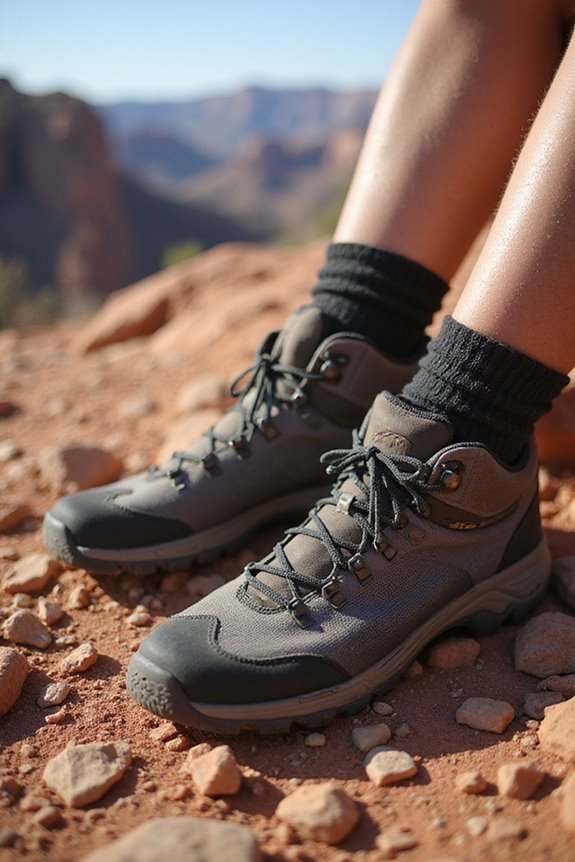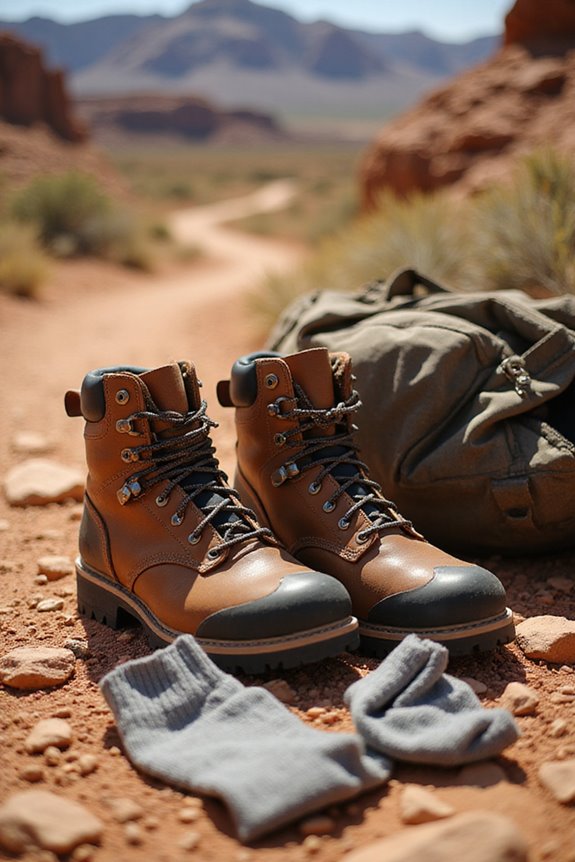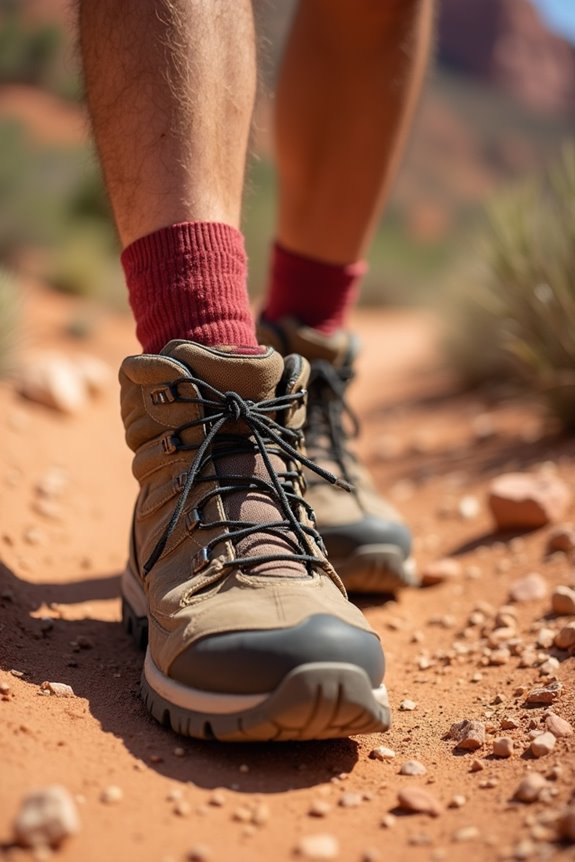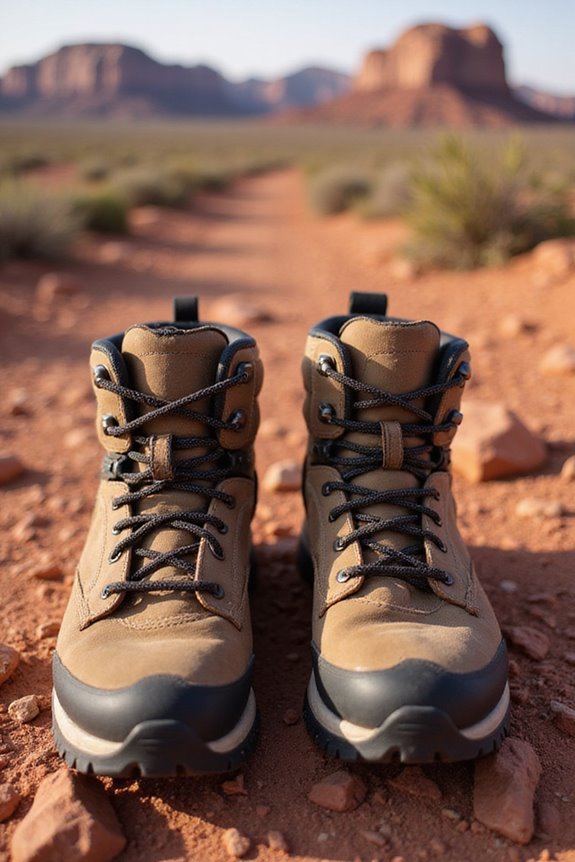When we’re hitting the trails, packing the right hiking socks is essential! We should always choose Merino wool for that soft feel and moisture-wicking power. Don’t forget to bring at least two pairs for short hikes or three for longer adventures—nothing’s worse than soggy socks! Make sure we check sizing and opt for high socks to fend off scrapes. Trust me, our feet will thank us later! Stick around, and we’ll uncover more tips to keep our feet happy on the trail.
Key Takeaways
- Pack at least 2 pairs of socks for short hikes and 3 pairs for multi-day trips to ensure proper rotation and hygiene.
- Choose socks made from Merino wool or blended materials for optimal moisture-wicking, warmth, and odor resistance.
- Consider the sock thickness according to the weather: lightweight for warm days and thicker options for colder conditions.
- Bring quick-drying socks to manage moisture effectively and prevent blisters during longer treks.
- Ensure a proper fit by selecting socks based on actual foot size, checking sizing charts to avoid blisters.
Material Matters: Choosing the Right Fabric
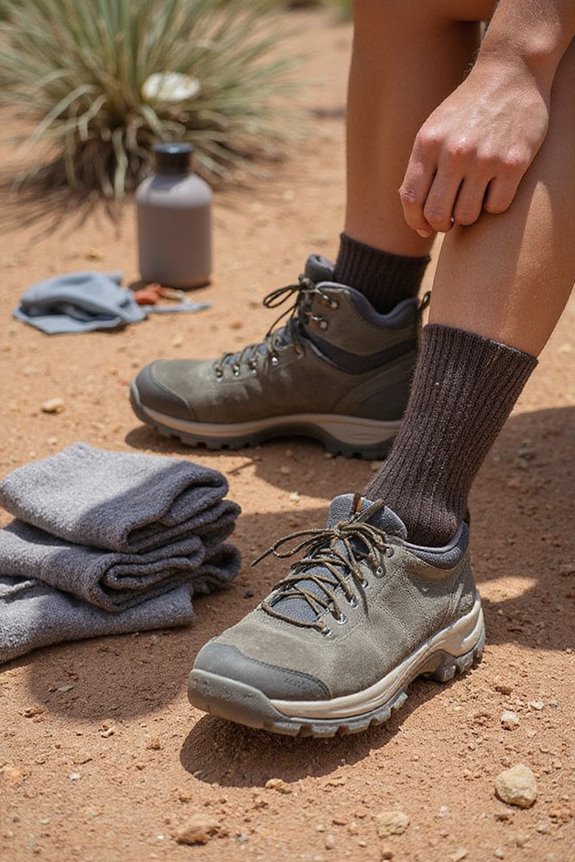
When we hit the trails, one of the first things we should consider is the fabric of our hiking socks—after all, our feet are the unsung heroes of our adventures! Choosing the right material is essential. Merino wool is a game-changer with its softness, amazing thermoregulation, and natural odor-fighting properties. It keeps our feet cozy in the cold and cool in the heat, making it perfect for all-day wear.
On the flip side, synthetic fabrics like nylon and polyester bring their own advantages, offering durability, elasticity, and moisture-wicking capabilities. Blending these materials creates the ultimate sock—a harmonious combo of Merino benefits and synthetic advantages. Some premium hiking socks even maintain performance in temperatures down to minus 10C, providing exceptional warmth without excessive bulk. So, let’s gear up with the right fabrics; our feet will thank us when we’re conquering trails!
Essential Features for Hiking Socks
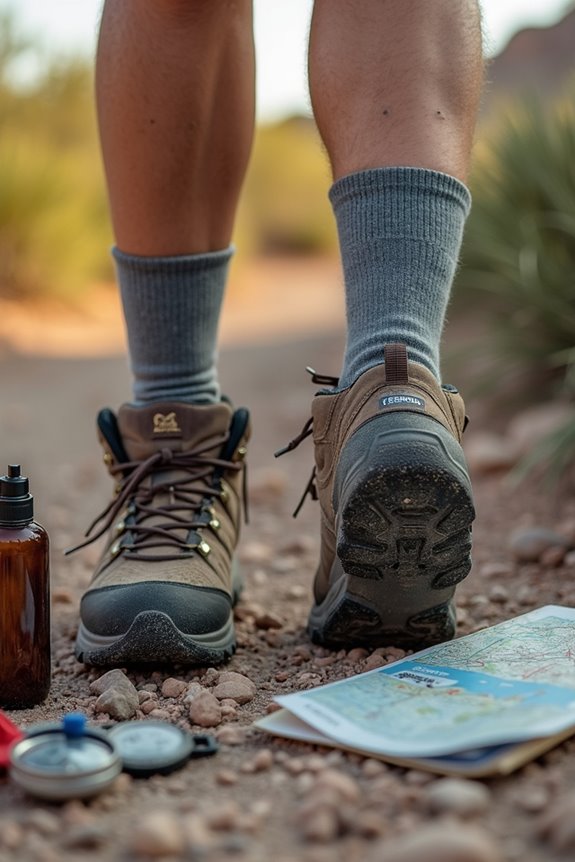
As we lace up our boots and prepare to take on rugged trails, it’s crucial to focus on the essential features of our hiking socks. First, let’s talk sock thickness! For warm days, we’ll want lightweight, breathable socks that won’t weigh us down. But in colder conditions, thicker options with great cushioning types can be our best friends, offering shock absorption and warmth. Consider materials like Merino wool for its excellent moisture-wicking properties while maintaining warmth on challenging hikes. We can’t forget fit – a snug sock prevents blisters, while those high socks are perfect for keeping scrapes and pesky insects at bay. Plus, flat seams are our heroes in the battle against friction. So, let’s gear up with the right features, and embrace the freedom of the trail without worrying about our feet! Happy hiking!
Sock Quantity: How Many to Bring
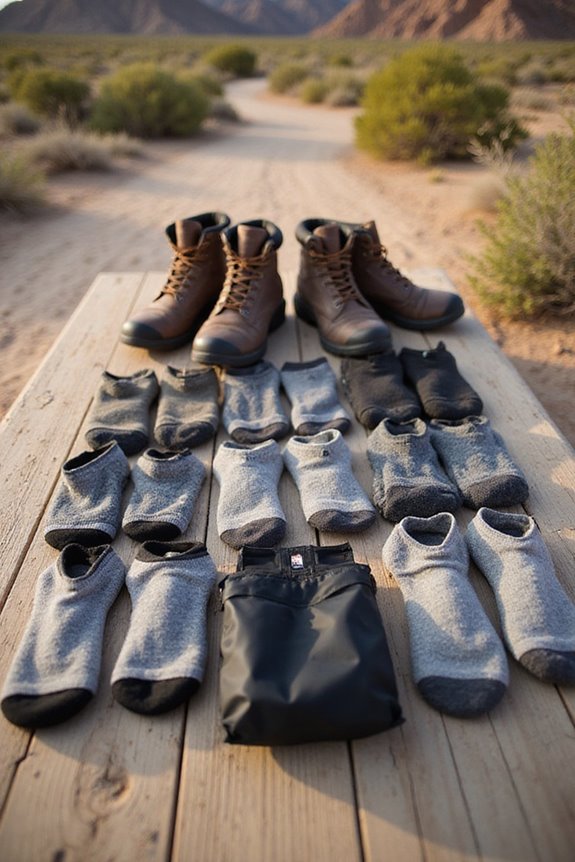
Packing just the right number of socks for our hiking adventures can make a huge difference in our comfort on the trail. For short weekend hikes, we usually need just 2 pairs—one for trekking and the other for when we kick back. But on multi-day trips, packing 3 pairs is ideal. This allows for proper sock rotation, helping with moisture management and keeping blisters at bay.
If we’re tackling longer treks, we might even consider packing a few extra pairs. Let’s face it, no one wants soggy feet after a rainstorm! Quick-drying socks can make all the difference. Ultimately, it’s about balance: foot care without overloading our packs. So, let’s choose wisely and enjoy every step! Socks with ventilation channels provide enhanced airflow and cooling effects that are essential during strenuous hiking activities.
Care and Maintenance on the Trail
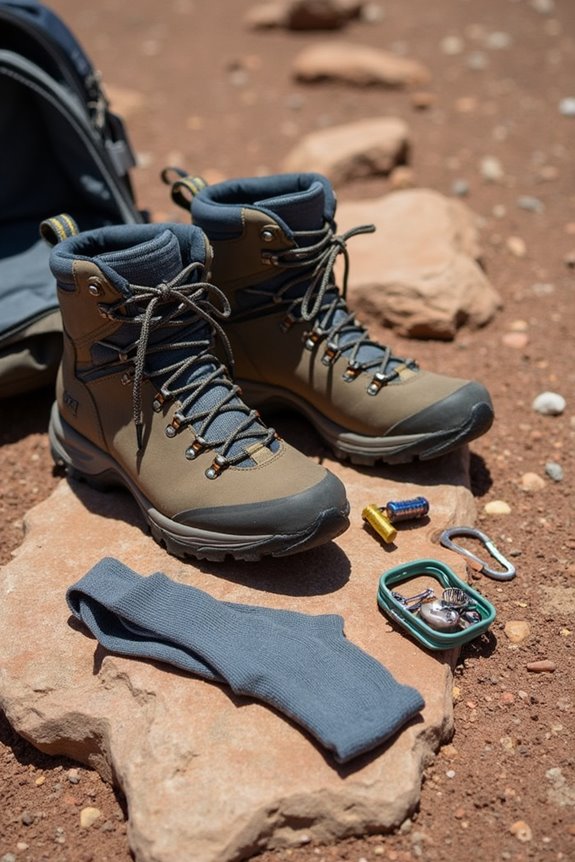
Taking care of our hiking socks on the trail can feel like a small task, but trust me, it’s a game changer for our feet! After those epic miles, let’s lay our socks flat, inside out if we can, to help with sock drying and avoid any funky odors. In the backcountry, wring out the moisture and hang them on tent lines or rock ledges.
If they get super soggy, switching socks and keeping moisture management on point is key. A little hand washing with biodegradable soap makes a world of difference—just remember to rinse far from water sources! Look for socks with high Merino content which naturally resist odors and regulate temperature even when damp. With a bit of care, our socks will keep us comfy and blister-free, ultimately freeing us to explore more trails!
Finding the Perfect Fit
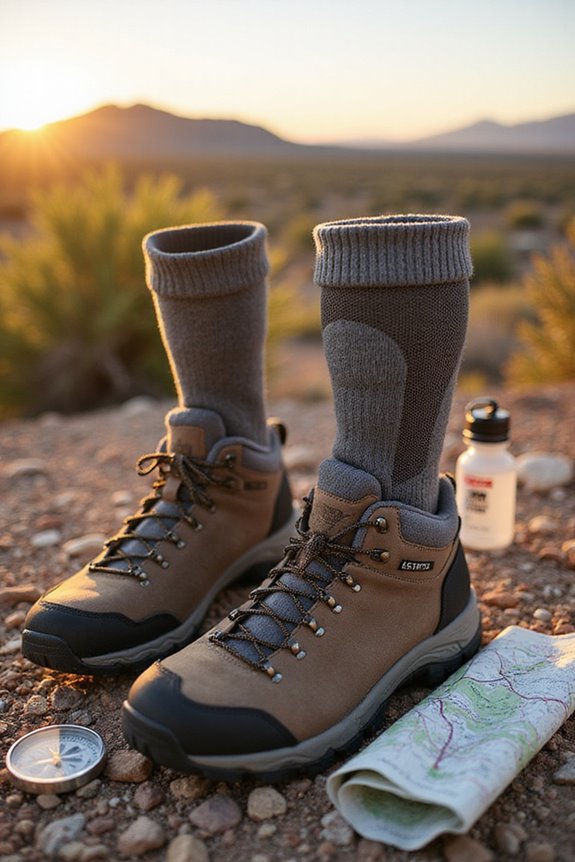
When it comes to hitting the trails, finding the perfect fit for our hiking socks can make or break our adventure! First off, let’s talk sock sizing: it’s essential to pick based on our actual foot size, not just shoe size. We’ve all felt that uncomfortable bunching, right? Opt for anatomically-designed socks—those tailored for left and right feet—because they hug our curves and reduce pressure points. If we’re between sizes, let’s size down to dodge blisters! A snug fit keeps our heels aligned perfectly, enhancing stability. Plus, taller socks provide extra warmth and protect against that pesky brush. Just like with hiking t-shirts, checking size charts beforehand can significantly improve your chances of finding the perfect fit. Trust us, when our feet feel good, we can conquer any trail with joy and freedom! Adventure awaits!
Layering Techniques for Comfort
Layering our socks might sound a bit excessive, but trust us—it’s a game changer on the trails! With sock layering, we can master moisture management, keeping our feet dry and blister-free. Starting with a snug liner sock, we’ll wick away sweat, creating that perfect dry environment. Then, we kick it up a notch with a thicker mid-layer for insulation and cushioning—because who likes icy toes or sore feet?
And let’s not forget the optional outer layer for extreme conditions, protecting our socks and adding warmth. By experimenting with cushion levels based on the trail, we’ll find our sweet spot. So, grab those socks, and let’s make our next hike a cozy adventure! Happy trails, friends!
Sustainability in Sock Selection
As we gear up for our next hiking escapade, thinking about the sustainability of our sock selection is more important than ever! We’re all about finding that sweet spot of comfort while being kind to Mother Earth, right? Choosing socks made from Merino wool or bamboo viscose not only guarantees we’re trekking with soft, moisture-wicking fabrics but also embraces sustainable sourcing.
Let’s keep an eye on eco-friendly certifications like OEKO-TEX or bluesign; they assure our socks are made responsibly. Plus, blended materials with recycled synthetics can extend durability, saving us from constantly replacing worn-out pairs. By making these conscious choices, we can hike freely with confidence, knowing our feet are supported—and so is the planet. Ready to step up for sustainability? Let’s do it!
Frequently Asked Questions
Can I Use Regular Socks for Hiking?
While we can use regular socks for hiking, they lack moisture-wicking properties and adequate cushioning. We’ll be better off with hiking sock materials that provide the right thickness and support for an adventurous experience.
How Can I Tell if Socks Are Worn Out?
When we’re evaluating our socks for wear, we should look for signs of durability loss and changes in materials. If they sag, smell, or have holes, it’s likely time for a replacement, ensuring our comfort.
Are Compression Socks Beneficial for Hiking?
Absolutely, those compression benefits are fantastic! We’ve noticed significant circulation improvement while hiking, which reduces fatigue and enhances our endurance. They make longer adventures more enjoyable, leaving us feeling ready for the next trail challenge.
What Colors Are Best for Hiking Socks?
When choosing colors for hiking socks, we consider color psychology and how vivid hues enhance visibility, while durable sock materials maintain comfort. Our choices reflect personal style and practicality, ensuring we stand out on trails.
Can I Wash Hiking Socks in a Washing Machine?
Ever wondered about sock care? We can definitely machine wash our hiking socks! With a few washing tips—gentle cycles, cool water, and mild soap—we’ll keep them in great shape for all our adventures ahead.


